Woman’s head
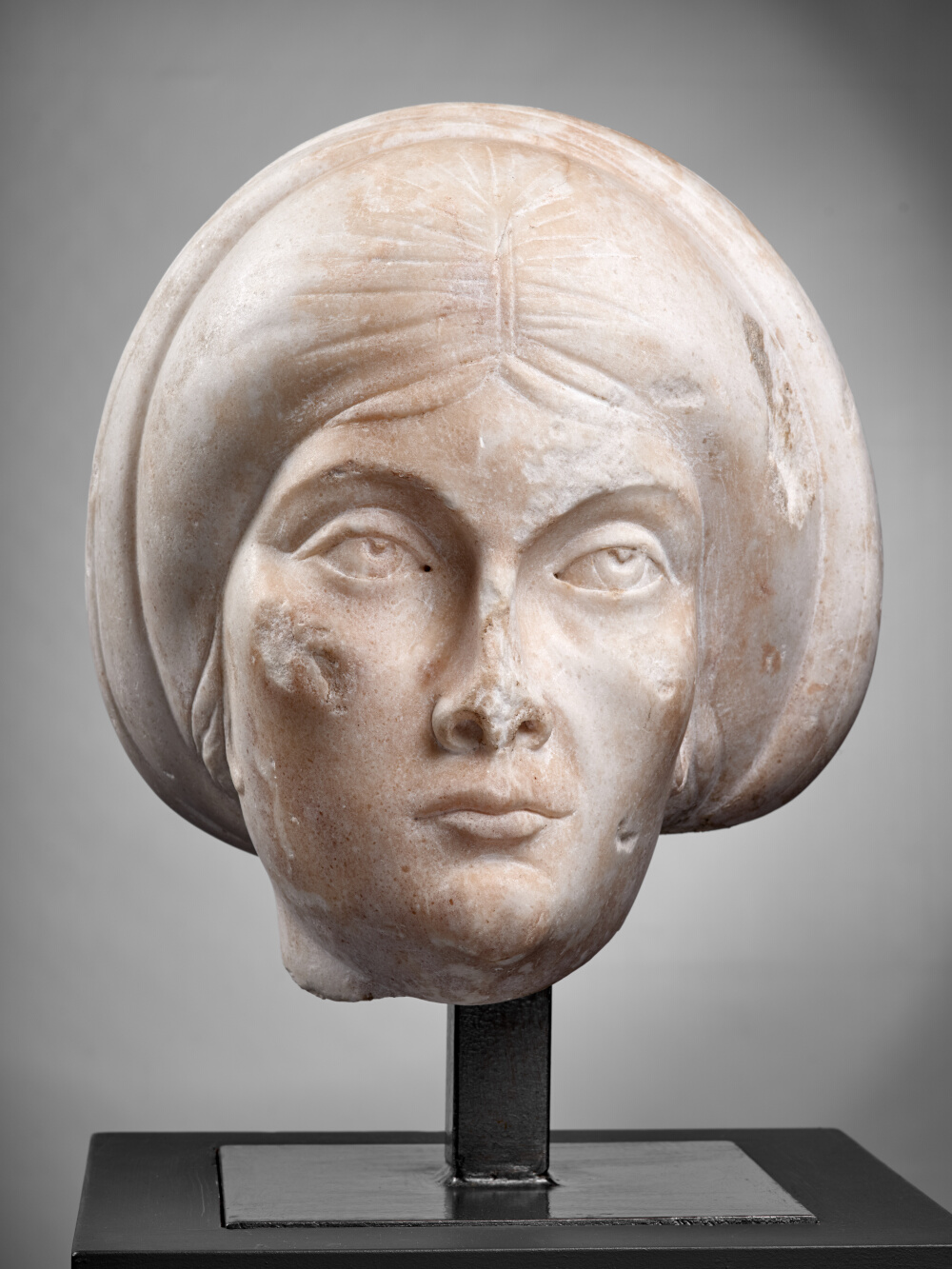
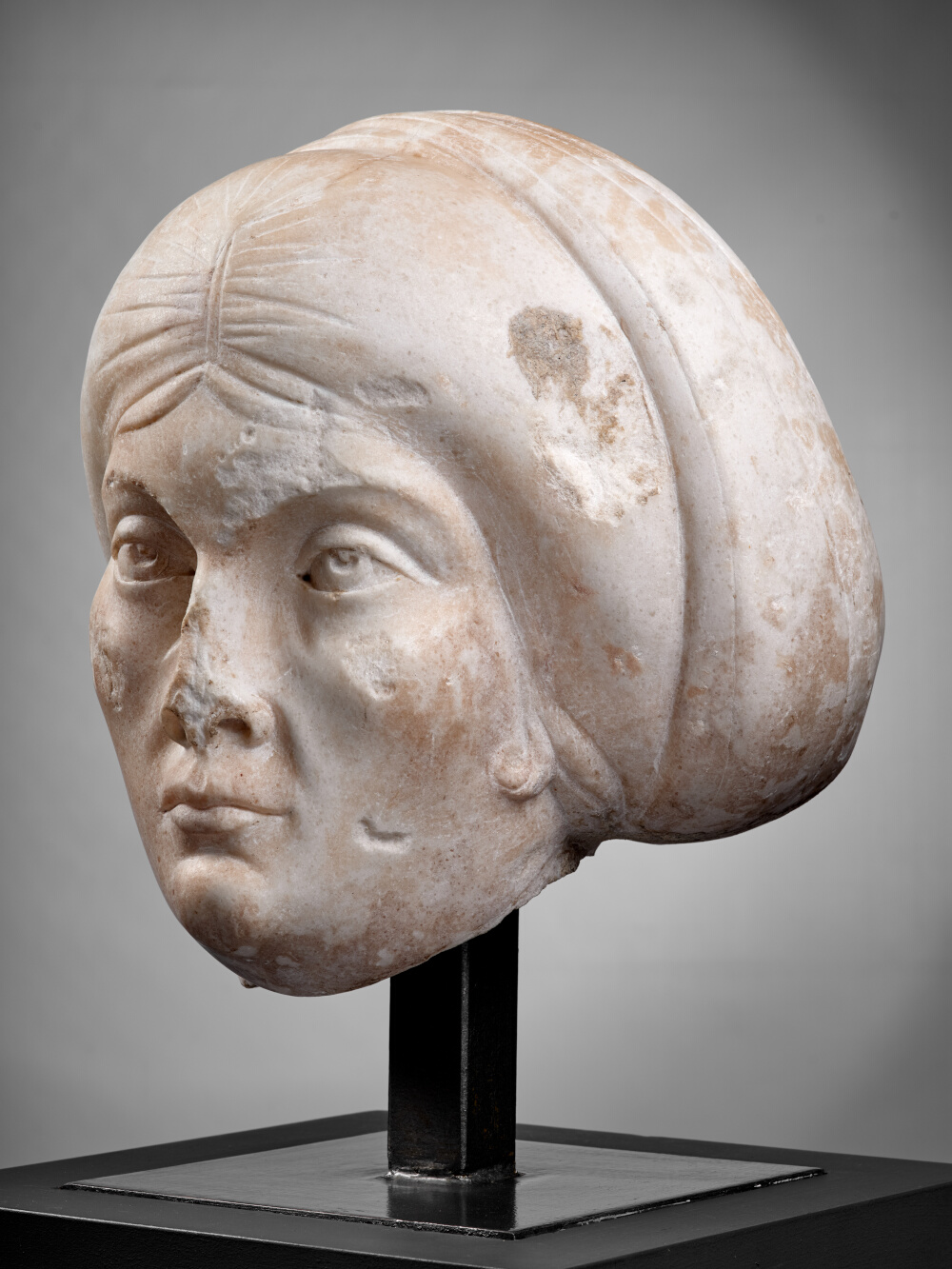
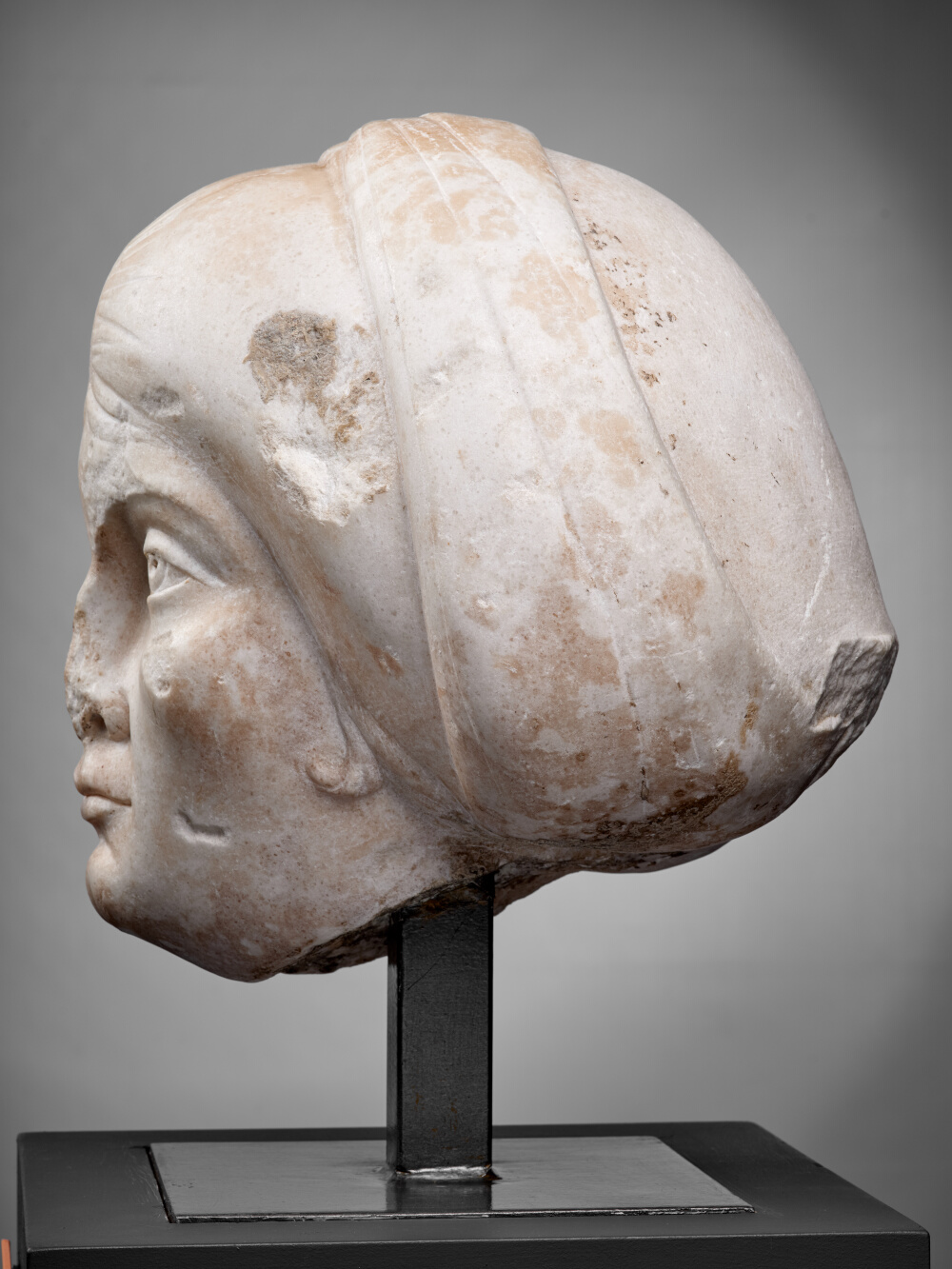
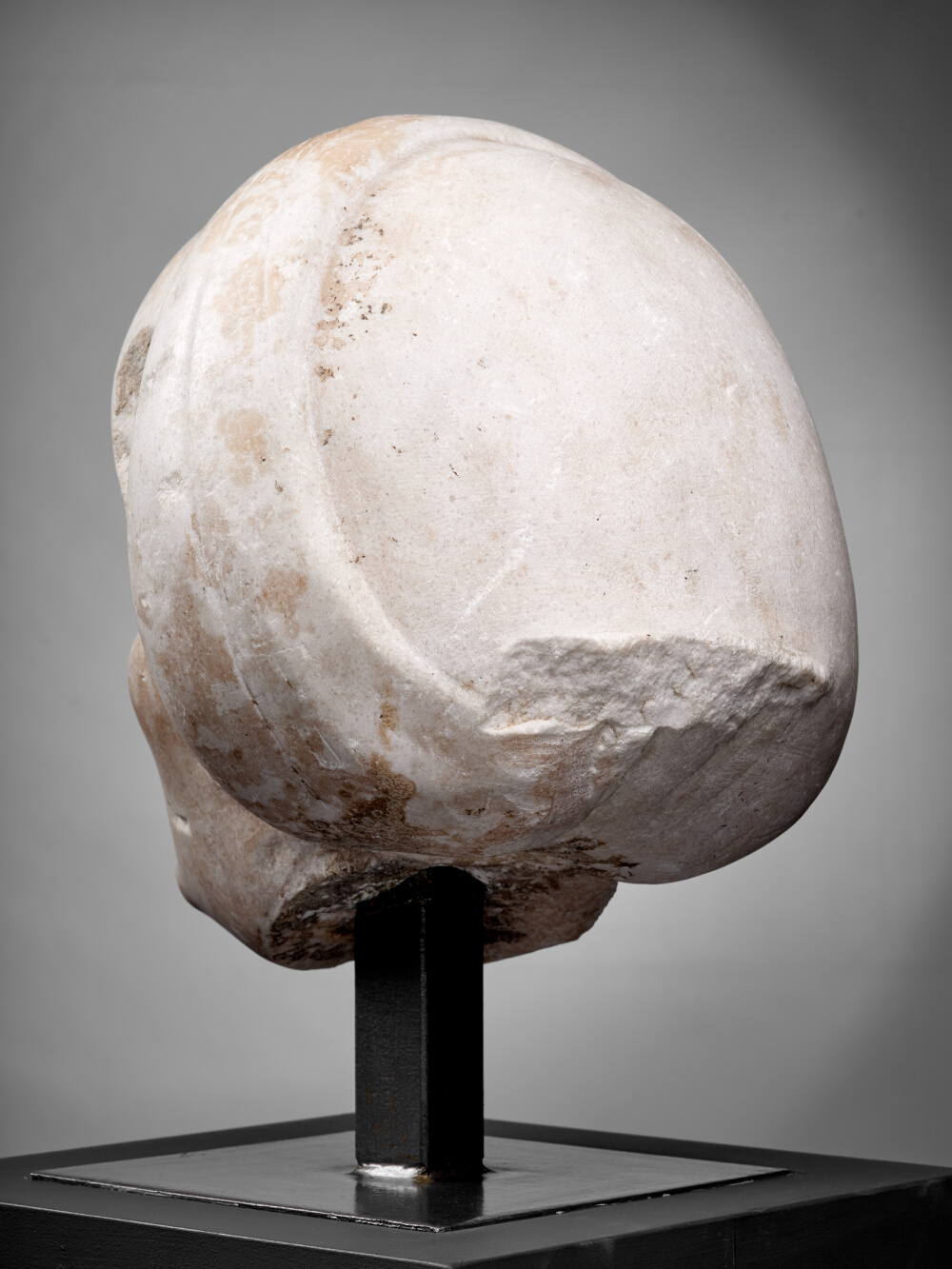
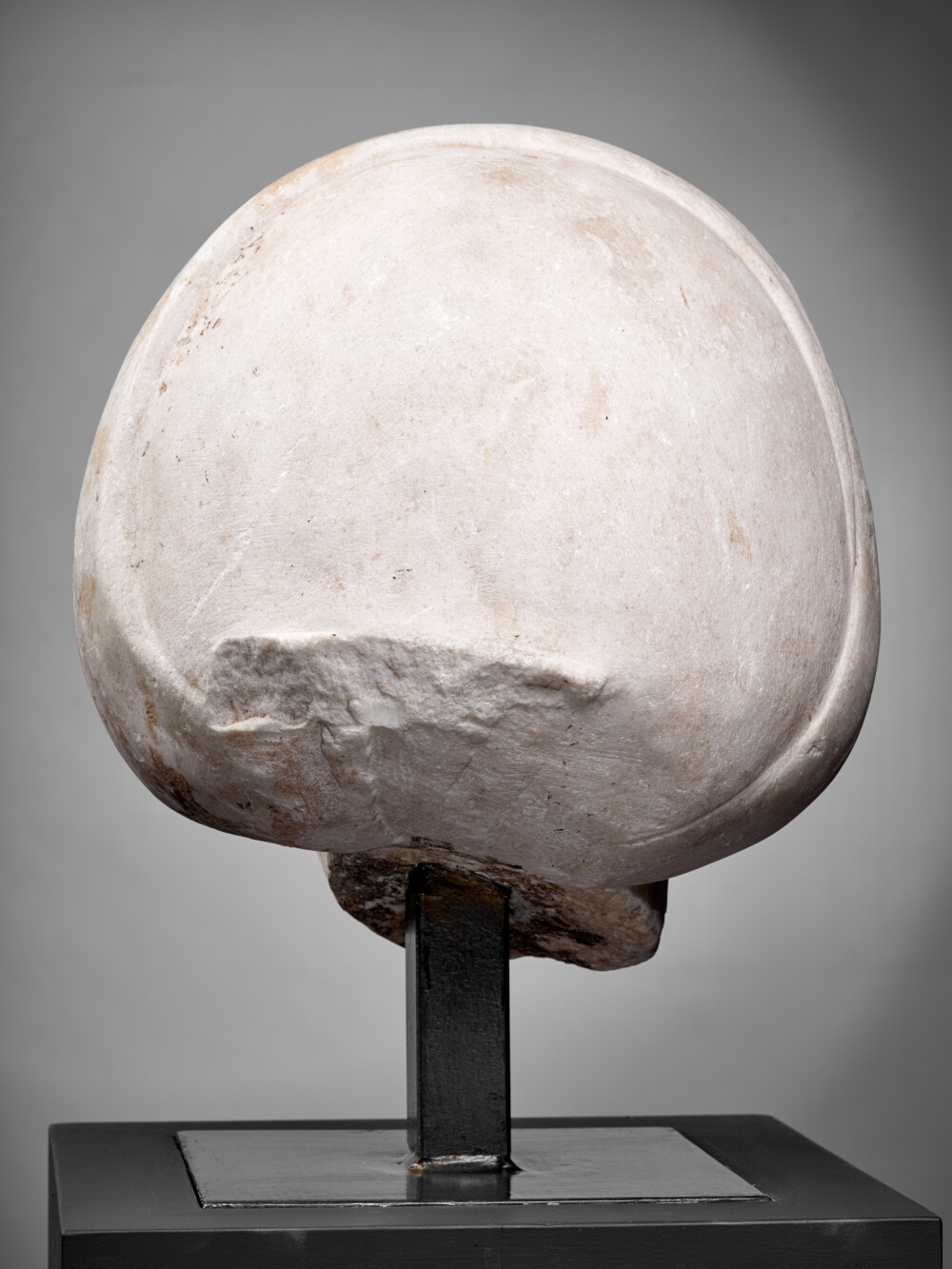
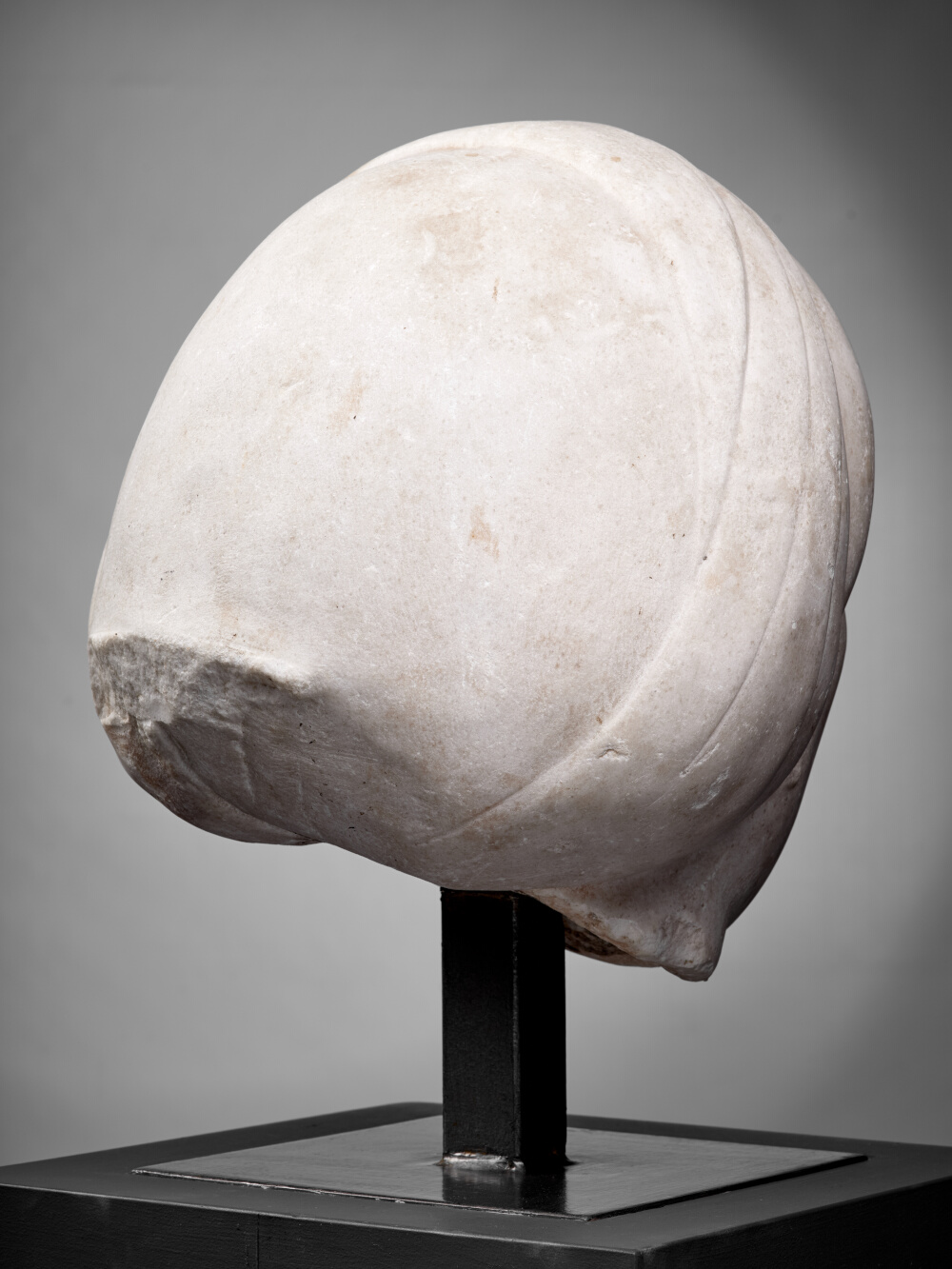
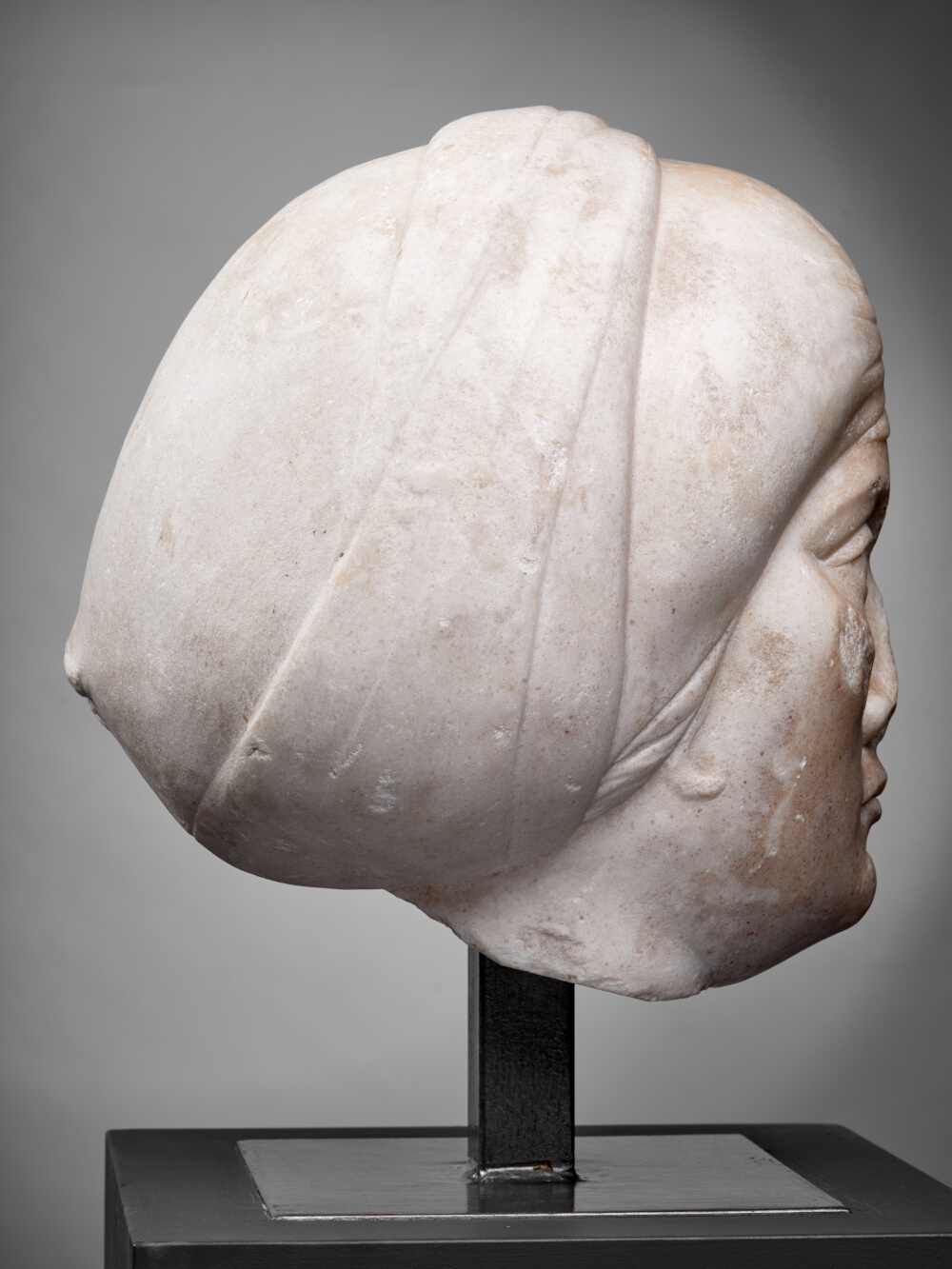
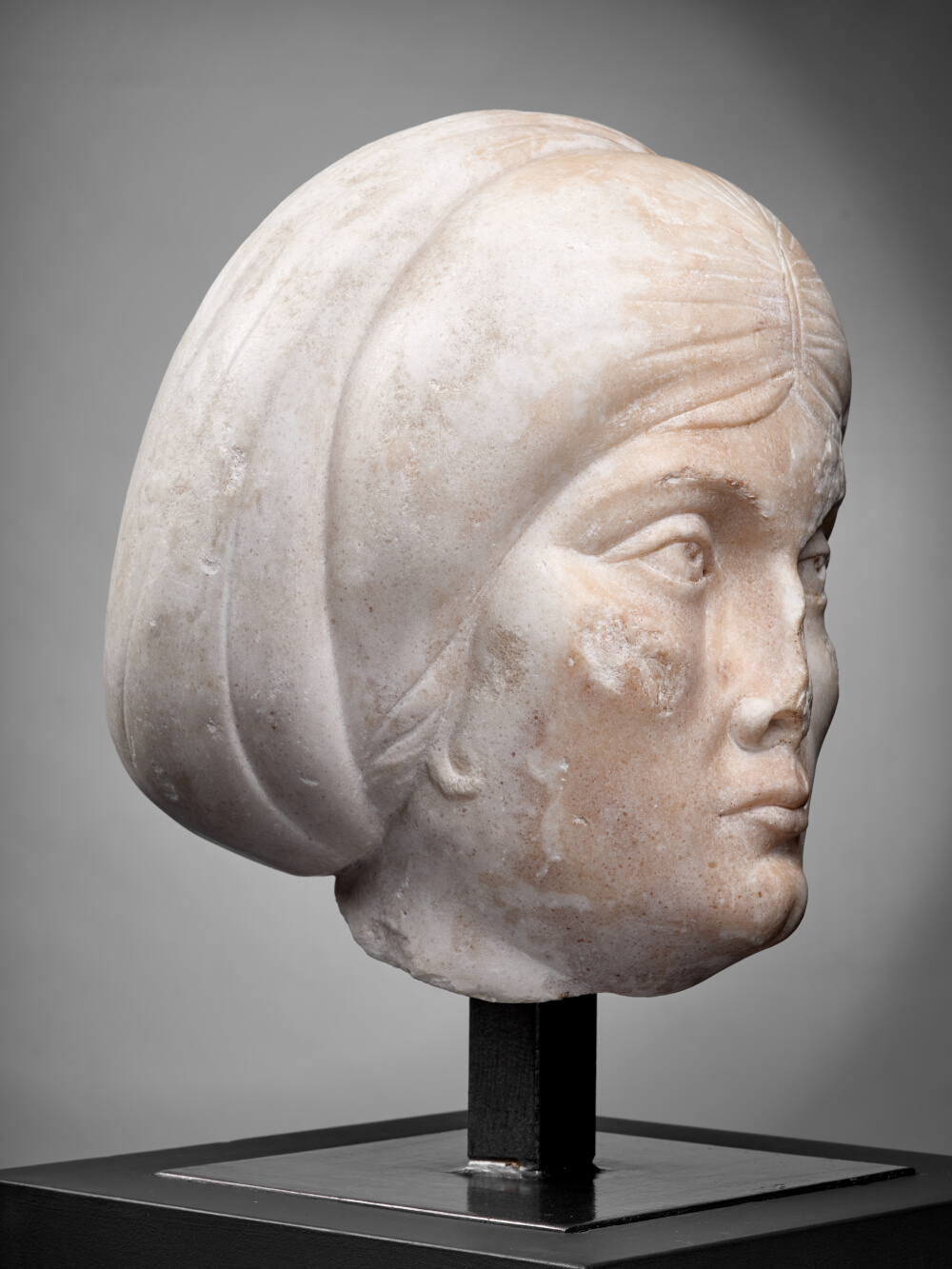
- Date de création
- The Theodosian dynasty. Approximately 375 - 425
- Material
- Saint-Béat marble (Haute-Garonne)
- Dimensions
- H. 33,5 x l. 30 x P. 30 (cm)
- Inventory number
- Ra 82
- Photo credits
- Daniel Martin
This female portrait clearly stands out from all the other faces discovered in Chiragan. What’s more, despite the assertions made by the curators Ernest Roschach (1865) and Henri Rachou (1912), we have no way of confirming that this work was actually found on the grounds of the villa on the banks of the Garonne.
This woman’s expression, which appears in turn stern or melancholic, depending on the angle from which she is viewed, commands deep respect. The cheekbones are prominent, as is the chin, there are shadows under the eyes, the eyelids are heavy, and the angular profile of the arches of the eyebrows extends, both graphically and geometrically, to form a long, fine nose. The nasolabial folds reflect the woman’s age, although she may be no more than forty D. Cazes, Périple méditerranéen : antiquités d’Afrique du Nord et du Moyen-Orient au Musée Saint-Raymond, musée des Antiques de Toulouse. Exhibition, Musée Saint-Raymond, Toulouse, 2003, Toulouse, 2003, p. 200.. The hairstyle is relatively similar to that of a 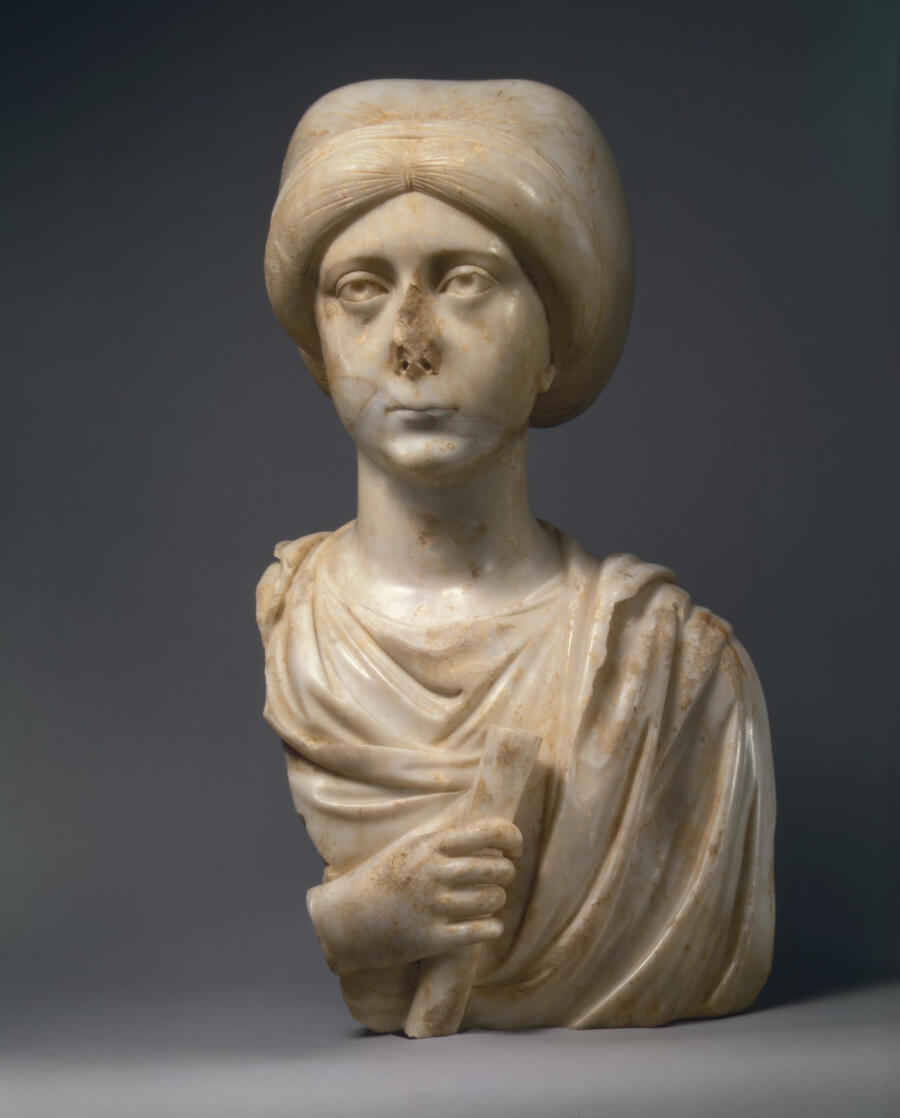 Byzantine bust of a young woman, kept at the Metropolitan Museum of Art in New York E. Alföldi-Rosenbaum, « Portrait Bust of a Young Lady of the Time of Justinian, » Metropolitan Museum Journal, 1, 1968, pp. 19–40, en partic. p. 21, fig. 2-5..
Byzantine bust of a young woman, kept at the Metropolitan Museum of Art in New York E. Alföldi-Rosenbaum, « Portrait Bust of a Young Lady of the Time of Justinian, » Metropolitan Museum Journal, 1, 1968, pp. 19–40, en partic. p. 21, fig. 2-5..
The schematic style and gravity of this noble face both point to a later date. The work is contemporary to the separation of the Eastern Roman Empire from the Western Roman Empire following the death of Theodosius I in 395. The reign of this emperor was therefore used as a reference point. In our opinion, this portrait probably goes back to the earliest date, the terminus post quem, or limit after which this portrait should be situated, the latest date being the end of the reign of Theodosius II, in the middle of the 5th century. This striking face can therefore be attributed to the reign of Theodosius. Yet, and contrary to justifiable belief, this work, which may have belonged to a statue, was designed neither in the East, nor in Rome in an oriental workshop, but in the foothills of the Pyrenees. The tests undertaken by D. Attanasio, M. Bruno and W. Prochaska reveal that the marble comes from Saint-Béat (Haute-Garonne). If this head was found on the Chiragan site, this information alone would prove not only the continued activity of the villa during this late period (coinage from the time of Theodosius and Arcadius was also found on site) but also the importance of its owners, under whose orders such experienced workshops laboured.
Another recently unearthed archaeological record must be taken into special consideration in the study of this portrait, the origin of which is uncertain. The record in question is a limestone head, discovered in 2005 within the framework of an archaeological intervention led by the Inrap, on the outskirts of Toulouse, on the site of Barricou, in Beauzelle. It was discovered in the fillings of one of the wells of a farm F. Veyssière, « L’occupation Antique Du Barricou à Beauzelle (Haute-Garonne), » Mémoires de la Société Archéologique du Midi de la France, LXVIII, 2008, pp. p. 327.. The same characteristic veil encircles the head, forming a band, which, in this case if more like a roll of fabric that frames a mature face with huge eyes. The representation of this Lady of Beauzelle belongs to a category of a sculpture that is conventionally referred to as « provincial ». Although the portrait is unforgiving and clumsy, it nevertheless allows for a common model to be taken into consideration, and therefore represents an interesting parallel. It would appear to bear witness to the notoriety of a person for whom an easily identifiable type of representation was created. This person, whose identity is now lost in the mist of time, must have wielded a certain power. Could this eminent figure have been part of the imperial circle?
Finally, it is worth remembering that a significant amount of small and medium sized statues retrieved from the ruins of the villa date back to the 4th and even to the first half of the 5th century. Whether inherited from previous owners or possible ancestors, or newly acquired, mythological sculptures, which had passed through the aesthetic filter of the Roman East, remained common in the middle of the 5th century. Thus, this portrait, which finds itself at the heart of such a collection, may not be as isolated as initially thought.
P. Capus
Bibliography
- Ensoli, La Rocca 2000 S. Ensoli, E. La Rocca (eds.), Aurea Roma : dalla città pagana alla città cristiana. Mostra, Palazzo delle esposizioni, Roma, 22 dicembre 2000-20 aprile 2001, Rome.
- Balmelle 2001 C. Balmelle, Les demeures aristocratiques d’Aquitaine : société et culture de l’Antiquité tardive dans le Sud-Ouest de la Gaule (Mémoires 5 – Aquitania, suppl. 10), Bordeaux-Paris. p. 83, fig. 22, p. 229-230
- Baratte 1996 F. Baratte, Histoire de l’art antique : l’art romain, Paris. p. 250-251
- Beckmann 2020 S.E. Beckmann, « The Idiom of Urban Display: Architectural Relief Sculpture in the Late Roman Villa of Chiragan (Haute-Garonne), » American Journal of Archaeology, 124, 1, pp. 133–160.
- Cazes 2003 D. Cazes, Périple méditerranéen : antiquités d’Afrique du Nord et du Moyen-Orient au Musée Saint-Raymond, musée des Antiques de Toulouse. Exhibition, Musée Saint-Raymond, Toulouse, 2003, Toulouse. p. 198-201, no 364
- Delbrueck 1933 R. Delbrueck, « Spätantike Kaiserporträts von Constantinus Magnus bis zum Ende des Westreichs, » (Studien zur spätantiken Kunstgeschichte), Berlin Leipzig. no 49 f, fig. 19
- Du Mège 1835 A. Du Mège, Description du musée des Antiques de Toulouse, Toulouse. p. 134-135, no 239
- Du Mège 1828 A. Du Mège, Notice des monumens antiques et des objets de sculpture moderne conservés dans le musée de Toulouse, Toulouse. p. 100, no 242
- Espérandieu 1908 É. Espérandieu, Recueil général des bas-reliefs de la Gaule romaine, 2. Aquitaine, Paris. p. 100, no 1030
- Eydoux 1962 H.P. Eydoux, La France antique, Paris. chap. XI, p. 179
- Eydoux, Carcopino 1958 H.P. Eydoux, J. Carcopino, Monuments et trésors de la Gaule : les récentes découvertes archéologiques, Paris. couv.
- Gauzi 1925 F. Gauzi, Au pays d’Oc, Toulouse : images et boniments, Toulouse. p. 84-85
- Kiilerich 1993 B. Kiilerich, Late Fourth Century Classicism in the Plastic Arts : Studies in the so-Called Theodosian Renaissance, Odense. p. 123-124, p. 354, fig. 68 bis
- Meischner 2001 J. Meischner, Bildnisse der Spätantike : 193 - 500, Problemfelder, die Privatporträts, Berlin. p. 403, pl. 92-fig. 2
- Meischner 1991 J. Meischner, « Das Porträt der theodosianischen Epoche, 2. 400 bis 460 n.Chr, » Jahrbuch des Deutschen Archäologischen Instituts, 106, pp. 385–407. p. 385‑407, no 106
- Rachou 1912 H. Rachou, Catalogue des collections de sculpture et d’épigraphie du musée de Toulouse, Toulouse. p. 52, no 82
- Roschach 1892 E. Roschach, Catalogue des musées archéologiques de la ville de Toulouse : Musée des Augustins, Musée Saint-Raymond, Toulouse. p. 38, no 79
- Stutzinger 1986 D. Stutzinger, « Das Bronzebildnis einer spätantiken Kaiserin aus Balajnac im Museum von Niš, » Jahrbuch für Antike und Christentum, 29, pp. 146–165. p. 155, no 37, pl. 26 b
- Veyne 2009 P. Veyne, Die Kunst der Spätantike : Geschichte eines Stilwandels, Stuttgart. p. 112
- Veyssière 2008 F. Veyssière, « L’occupation Antique Du Barricou à Beauzelle (Haute-Garonne), » Mémoires de la Société Archéologique du Midi de la France, LXVIII, pp. p. 327. p. 327
- von Heintze 1971 H. von Heintze, « Ein Spätantikes Mädchenporträt in Bonn. Zur Stilistischen Entwicklung Des Frauenbildnisses Im 4. Und 5. Jahrhundert, » Jahrbuch Für Antike Und Christentum, 14, pp. 61–91. p. 90, no 104
- Alföldi-Rosenbaum 1968 E. Alföldi-Rosenbaum, « Portrait Bust of a Young Lady of the Time of Justinian, » Metropolitan Museum Journal, 1, pp. 19–40. p. 35-40, fig. 25-28
- Centre culturel Abbaye de Daoulas 1993 Centre culturel Abbaye de Daoulas, Rome face aux Barbares : 1000 ans pour un empire. Exhibition, Abbaye de Daoulas, 19 June - 26 September 1993, Daoulas. no 85.07
- Musée Saint-Raymond 2020 Musée Saint-Raymond, Wisigoths : rois de Toulouse. Exhibition, Musée Saint-Raymond, Toulouse, 27 February - 27 December 2020, Toulouse. p. 71-72
- Mussot-Goulard 1999 R. Mussot-Goulard, Les Goths, Biarritz. p. 114
- Musée Saint-Raymond 2011 Musée Saint-Raymond, L’essentiel des collections (Les guides du MSR), Toulouse. p. 48-49
- Musée Saint-Raymond 1995 Musée Saint-Raymond, Le regard de Rome : portraits romains des musées de Mérida, Toulouse et Tarragona. Exhibition, Mérida, Museo nacional de arte romano ; Toulouse, Musée Saint-Raymond ; Tarragone, Museu nacional arqueològic de Tarragona, 1995, Toulouse. p. 45, no 7
- Popova-Moroz, Bachvarov 1992 V. Popova-Moroz, I. Bachvarov, « Roman Portraiture from Durostorum and Its Territory, » Dacia Revue d’archéologie et d’histoire ancienne, XXXVI. p. 13-21. (bibl. de comp.)
To cite this notice
Capus P., "Woman’s head", in The sculptures of the roman villa of Chiragan, Toulouse, 2019, online <https://villachiragan.saintraymond.toulouse.fr/en/ark:/87276/a_ra_82>.